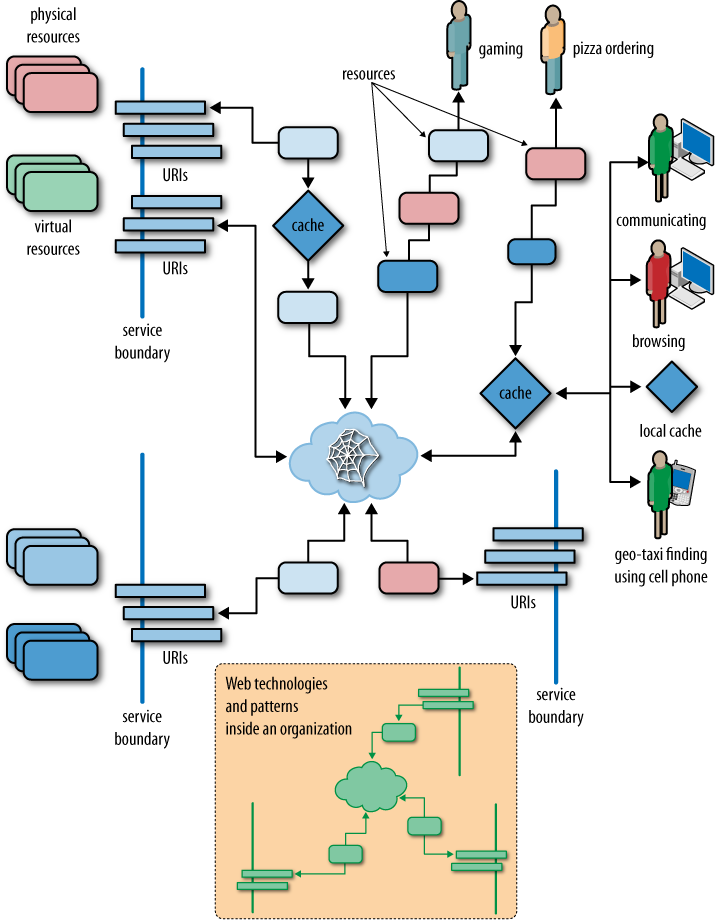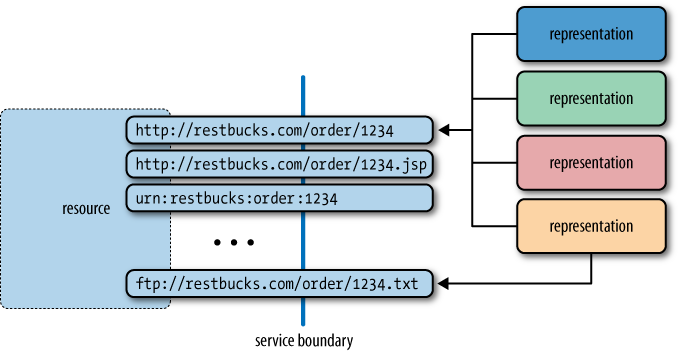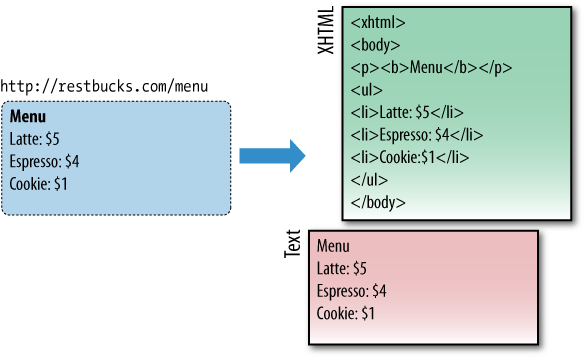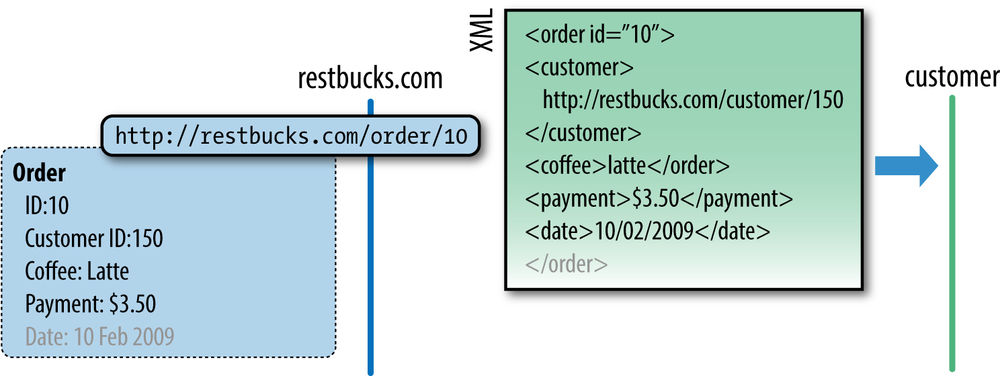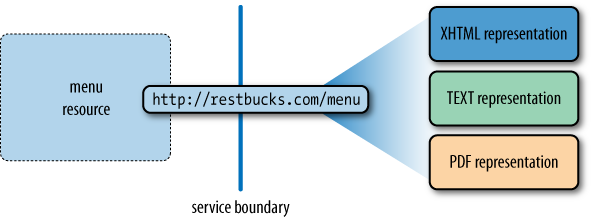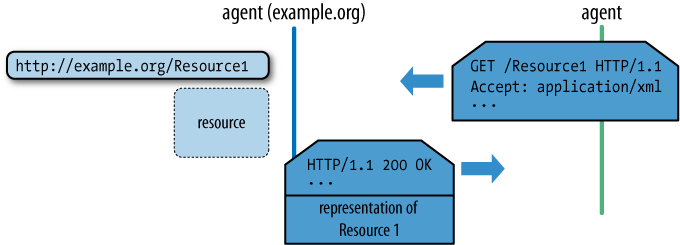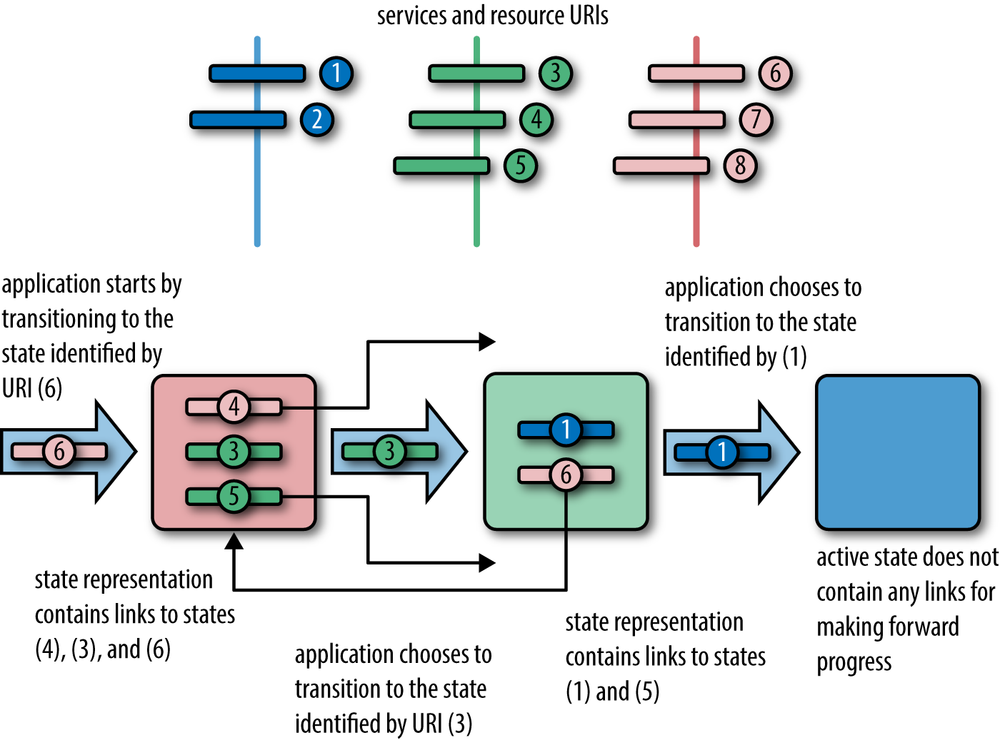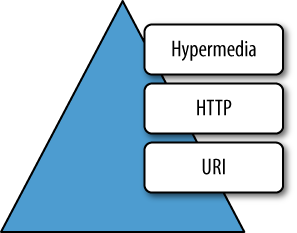Chapter 1. The Web As a Platform for Building Distributed Systems
THE WEB HAS RADICALLY TRANSFORMED THE WAY we produce and share information. Its international ecosystem of applications and services allows us to search, aggregate, combine, transform, replicate, cache, and archive the information that underpins todayâs digital society. Successful despite its chaotic growth, it is the largest, least formal integration project ever attemptedâall of this, despite having barely entered its teenage years.
Todayâs Web is in large part the human Web: human users are the direct consumers of the services offered by the majority of todayâs web applications. Given its success in managing our digital needs at such phenomenal scale, weâre now starting to ask how we might apply the Webâs underlying architectural principles to building other kinds of distributed systems, particularly the kinds of distributed systems typically implemented by âenterprise applicationâ developers.
Why is the Web such a successful application platform? What are its guiding principles, and how should we apply them when building distributed systems? What technologies can and should we use? Why does the Web model feel familiar, but still different from previous platforms? Conversely, is the Web always the solution to the challenges we face as enterprise application developers?
These are the questions weâll answer in the rest of this book. Our goal throughout is to describe how to build distributed systems based on the Webâs architecture. We show how to implement systems that use the Webâs predominant application protocol, HyperText Transfer Protocol (HTTP), and which leverage RESTâs architectural tenets. We explain the Webâs fundamental principles in simple terms and discuss their relevance in developing robust distributed applications. And we illustrate all this with challenging examples drawn from representative enterprise scenarios and solutions implemented using Java and .NET.
The remainder of this chapter takes a first, high-level look at the Webâs architecture. Here we discuss some key building blocks, touch briefly on the REpresentational State Transfer (REST) architectural style, and explain why the Web can readily be used as a platform for connecting services at global scale. Subsequent chapters dive deeper into the Webâs principles and discuss the technologies available for connecting systems in a web-friendly manner.
Architecture of the Web
Tim Berners-Lee designed and built the foundations of the World Wide Web while a research fellow at CERN in the early 1990s. His motivation was to create an easy-to-use, distributed, loosely coupled system for sharing documents. Rather than starting from traditional distributed application middleware stacks, he opted for a small set of technologies and architectural principles. His approach made it simple to implement applications and author content. At the same time, it enabled the nascent Web to scale and evolve globally. Within a few years of the Webâs birth, academic and research websites had emerged all over the Internet. Shortly thereafter, the business world started establishing a web presence and extracting web-scale profits from its use. Today the Web is a heady mix of business, research, government, social, and individual interests.
This diverse constituency makes the Web a chaotic placeâthe only consistency being the consistent variety of the interests represented there; the only unifying factor the seemingly never-ending thread of connections that lead from gaming to commerce, to dating to enterprise administration, as we see in Figure 1-1.
Despite the emergent chaos at global scale, the Web is remarkably simple to understand and easy to use at local scale. As documented by the World Wide Web Consortium (W3C) in its âArchitecture of the World Wide Web,â the anarchic architecture of todayâs Web is the culmination of thousands of simple, small-scale interactions between agents and resources that use the founding technologies of HTTP and the URI.[1]
The Webâs architecture, as portrayed in Figure 1-1, shows URIs and resources playing a leading role, supported by web caches for scalability. Behind the scenes, service boundaries support isolation and independent evolution of functionality, thereby encouraging loose coupling. In the enterprise, the same architectural principles and technology can be applied.
Traditionally weâve used middleware to build distributed systems. Despite the amount of research and development that has gone into such platforms, none of them has managed to become as pervasive as the Web is today. Traditional middleware technologies have always focused on the computer science aspects of distributed systems: components, type systems, objects, remote procedure calls, and so on.
The Webâs middleware is a set of widely deployed and commoditized servers. From the obviousâweb servers that host resources (and the data and computation that back them)âto the hidden: proxies, caches, and content delivery networks, which manage traffic flow. Together, these elements support the deployment of a planetary-scale network of systems without resorting to intricate object models or complex middleware solutions.
This low-ceremony middleware environment has allowed the Webâs focus to shift to information and document sharing using hypermedia. While hypermedia itself was not a new idea, its application at Internet scale took a radical turn with the decision to allow broken links. Although weâre now nonplussed (though sometimes annoyed) at the classic â404 Page Not Foundâ error when we use the Web, this modest status code set a new and radical direction for distributed computing: it explicitly acknowledged that we canât be in control of the whole system all the time.
Compared to classic distributed systems thinking, the Webâs seeming ambivalence to dangling pointers is heresy. But it is precisely this shift toward a web-centric way of building computer systems that is the focus of this book.
Thinking in Resources
Resources are the fundamental building blocks of web-based systems, to the extent that the Web is often referred to as being âresource-oriented.â A resource is anything we expose to the Web, from a document or video clip to a business process or device. From a consumerâs point of view, a resource is anything with which that consumer interacts while progressing toward some goal. Many real-world resources might at first appear impossible to project onto the Web. However, their appearance on the Web is a result of our abstracting out their useful information aspects and presenting these aspects to the digital world. A flesh-and-blood or bricks-and-mortar resource becomes a web resource by the simple act of making the information associated with it accessible on the Web. The generality of the resource concept makes for a heterogeneous community. Almost anything can be modeled as a resource and then made available for manipulation over the network: âRoyâs dissertation,â âthe movie Star Wars,â âthe invoice for the books Jane just bought,â âPaulâs poker bot,â and âthe HR process for dealing with new hiresâ all happily coexist as resources on the Web.
Resources and Identifiers
To use a resource we need both to be able to identify it on the network and to have some means of manipulating it. The Web provides the Uniform Resource Identifier, or URI, for just these purposes. A URI uniquely identifies a web resource, and at the same time makes it addressable, or capable of being manipulated using an application protocol such as HTTP (which is the predominant protocol on the Web). A resourceâs URI distinguishes it from any other resource, and itâs through its URI that interactions with that resource take place.
The relationship between URIs and resources is many-to-one. A URI identifies only one resource, but a resource can have more than one URI. That is, a resource can be identified in more than one way, much as humans can have multiple email addresses or telephone numbers. This fits well with our frequent need to identify real-world resources in more than one way.
Thereâs no limit on the number of URIs that can refer to a resource, and it is in fact quite common for a resource to be identified by numerous URIs, as shown in Figure 1-2. A resourceâs URIs may provide different information about the location of the resource, or the protocol that can be used to manipulate it. For example, the Google home page (which is, of course, a resource) can be accessed via both http://www.google.com and http://google.com URIs.
Note
Although several URIs can identify the same resource, the Web doesnât provide any way to compute whether two different URIs actually refer to the same resource. As developers, we should never assume that two URIs refer to different resources based merely on their syntactic differences. Where such comparisons are important, we should draw on Semantic Web technologies, which offer vocabularies for declaring resource identity sameness. We will discuss some useful techniques from semantic computing later in the book.
A URI takes the form <scheme>:<scheme-specific-structure>. The scheme defines how the rest of the identifier is to be interpreted. For example, the http part of a URI such as http://example.org/reports/book.tar tells us that the rest of the URI must be interpreted according to the HTTP scheme. Under this scheme, the URI identifies a resource at a machine that is identified by the hostname example.org using DNS lookup. Itâs the responsibility of the machine âlisteningâ at example.org to map the remainder of the URI, reports/book.tar, to the actual resource. Any authorized software agent that understands the HTTP scheme can interact with this resource by following the rules set out by the HTTP specification (RFC 2616).
Note
Although weâre mostly familiar with HTTP URIs from browsing
the Web, other forms are supported too. For example, the well-known
FTP scheme[2] suggests that a URI such as
ftp://example.org/reports/book.txt should be
interpreted in the following way: example.org is the Domain Name System (DNS) name of the computer that
knows File Transfer Protocol (FTP),
reports is interpreted as the argument to the
CWD (Change Working Directory)
command, and book.txt is a
filename that can be manipulated through FTP commands, such as
RETR for retrieving the
identified file from the FTP server. Similarly, the
mailto URI scheme is used to identify email
addresses: mailto:enquiries@restbucks.com.
The mechanism we can use to interact with a resource cannot always be inferred as easily as the HTTP case suggests; the URN scheme, for example, is not associated with a particular interaction protocol.
In addition to URI, several other terms are used to refer to web resource identifiers. Table 1-1 presents a few of the more common terms, including URN and URL, which are specific forms of URIs, and IRI, which supports international character sets.
Term | Comments |
URI (Uniform Resource Identifier) | This is often incorrectly referred to as a âUniversalâ or âUniqueâ Resource Identifier; âUniformâ is the correct expansion. |
This is an update to the definition of URI to allow the use of international characters. | |
This is a URI with âurnâ as the scheme, used to convey unique names in a particular ânamespace.â The namespace is defined as part of the URNâs structure. For example, a bookâs ISBN can be captured as a unique name: urn:isbn:0131401602. | |
This is a URI used to convey information about the way in which one interacts with the identified resource. For example, http://google.com identifies a resource on the Web with which communication is possible through HTTP. This term is now obsolete, since not all URIs need to convey interaction-protocol-specific information. However, the term is part of the Webâs history and is still widely in use. | |
Address | Many think of resources as having âaddressesâ on the Web and, as a result, refer to their identifiers as such. |
Resource Representations
The Web is so pervasive that the HTTP URI scheme is today a common synonym for both identity and address. In the web-based solutions presented in this book, weâll use HTTP URIs exclusively to identify resources, and weâll often refer to these URIs using the shorthand term address.
Resources must have at least one identifier to be addressable on the Web, and each identifier is associated with one or more representations. A representation is a transformation or a view of a resourceâs state at an instant in time. This view is encoded in one or more transferable formats, such as XHTML, Atom, XML, JSON, plain text, comma-separated values, MP3, or JPEG.
For real-world resources, such as goods in a warehouse, we can distinguish between the actual object and the logical âinformationâ resource encapsulated by an application or service. Itâs the information resource that is made available to interested parties through projecting its representations onto the Web. By distinguishing between the ârealâ and the âinformationâ resource, we recognize that objects in the real world can have properties that are not captured in any of their representations. In this book, weâre primarily interested in representations of information resources, and where we talk of a resource or âunderlying resource,â itâs the information resource to which weâre referring.
Access to a resource is always mediated by way of its representations. That is, web components exchange representations; they never access the underlying resource directlyâthe Web does not support pointers! URIs relate, connect, and associate representations with their resources on the Web. This separation between a resource and its representations promotes loose coupling between backend systems and consuming applications. It also helps with scalability, since a representation can be cached and replicated.
Note
The terms resource representation and resource are often used interchangeably. It is important to understand, though, that there is a difference, and that there exists a one-to-many relationship between a resource and its representations.
There are other reasons we wouldnât want to directly expose the state of a resource. For example, we may want to serve different views of a resourceâs state depending on which user or application interacts with it, or we may want to consider different quality-of-service characteristics for individual consumers. Perhaps a legacy application written for a mainframe requires access to invoices in plain text, while a more modern application can cope with an XML or JSON representation of the same information. Each representation is a view onto the same underlying resource, with transfer formats negotiated at runtime through the Webâs content negotiation mechanism.
The Web doesnât prescribe any particular structure or format for resource representations; representations can just as well take the form of a photograph or a video as they can a text file or an XML or JSON document. Given the range of options for resource representations, it might seem that the Web is far too chaotic a choice for integrating computer systems, which traditionally prefer fewer, more structured formats. However, by carefully choosing a set of appropriate representation formats, we can constrain the Webâs chaos so that it supports computer-to-computer interactions.
Resource representation formats serve the needs of service consumers. This consumer friendliness, however, does not extend to allowing consumers to control how resources are identified, evolved, modified, and managed. Instead, services control their resources and how their states are represented to the outside world. This encapsulation is one of the key aspects of the Webâs loose coupling.
The success of the Web is linked with the proliferation and wide acceptance of common representation formats. This ecosystem of formats (which includes HTML for structured documents, PNG and JPEG for images, MPEG for videos, and XML and JSON for data), combined with the large installed base of software capable of processing them, has been a catalyst in the Webâs success. After all, if your web browser couldnât decode JPEG images or HTML documents, the human Web would have been stunted from the start, despite the benefits of a widespread transfer protocol such as HTTP.
To illustrate the importance of representation formats, in Figure 1-3 weâve modeled the menu of a new coffee store called Restbucks (which will provide the domain for examples and explanations throughout this book). We have associated this menu with an HTTP URI. The publication of the URI surfaces the resource to the Web, allowing software agents to access the resourceâs representation(s).
In this example, we have decided to make only XHTML and text-only representations of the resource available. Many more representations of the same announcement could be served using formats such as PDF, JPEG, MPEG video, and so on, but we have made a pragmatic decision to limit our formats to those that are both human- and machine-friendly.
Typically, resource representations such as those in Figure 1-3 are meant for human consumption via a web browser. Browsers are the most common computer agents on the Web today. They understand protocols such as HTTP and FTP, and they know how to render formats such as (X)HTML and JPEG for human consumption. Yet, as we move toward an era of computer systems that span the Web, there is no reason to think of the web browser as the only important software agent, or to think that humans will be the only active consumers of those resources. Take Figure 1-4 as an example. An order resource is exposed on the Web through a URI. Another software agent consumes the XML representation of the order as part of a business-to-business process. Computers interact with one another over the Web, using HTTP, URIs, and representation formats to drive the process forward just as readily as humans.
Representation Formats and URIs
There is a misconception that different resource representations should each have their own URIâa notion that has been popularized by the Rails framework. With this approach, consumers of a resource terminate URIs with .xml or .json to indicate a preferred format, requesting http://restbucks.com/order.xml or http://example.org/order.json as they see fit. While such URIs convey intent explicitly, the Web has a means of negotiating representation formats that is a little more sophisticated.
Note
URIs should be opaque to consumers. Only the issuer of the URI knows how to interpret and map it to a resource. Using extensions such as .xml, .html, or .json is a historical convention that stems from the time when web servers simply mapped URIs directly to files.
In the example in Figure 1-3, we hinted at the availability of two representation formats: XHTML and plain text. But we didnât specify two separate URIs for the representations. This is because there is a one-to-many association between a URI and its possible resource representations, as Figure 1-5 illustrates.
Using content negotiation, consumers can
negotiate for specific representation formats from a service. They do
so by populating the HTTP Accept
request header with a list of media types theyâre prepared to process.
However, it is ultimately up to the owner of a resource to decide what
constitutes a good representation of that resource in the context of
the current interaction, and hence which format should be
returned.
The Art of Communication
Itâs time to bring some threads together to see how resources, representation formats, and URIs help us build systems. On the Web, resources provide the subjects and objects with which we want to interact, but how do we act on them? The answer is that we need verbs, and on the Web these verbs are provided by HTTP methods.[4]
The term uniform interface is used to describe how a (small) number of verbs with well-defined and widely accepted semantics are sufficient to meet the requirements of most distributed applications. A collection of verbs is used for communication between systems.
Note
In theory, HTTP is just one of the many interaction protocols that can be used to support a web of resources and actions, but given its pervasiveness we will assume that HTTP is the protocol of the Web.
In contemporary distributed systems thinking, itâs a popular
idea that the set of verbs supported by HTTPâGET, POST, PUT, DELETE, OPTIONS, HEAD, TRACE,
CONNECT, and PATCHâforms
a sufficiently general-purpose protocol to support a wide range of
solutions.
Note
In reality, these verbs are used with differing frequencies on the Web, suggesting that an even smaller subset is usually enough to satisfy the requirements of many distributed applications.
In addition to verbs, HTTP also defines a collection of response
codes, such as 200 OK, 201 Created,
and 404 Not Found, that coordinate
the interactions instigated by the use of the verbs. Taken together,
verbs and status codes provide a general framework for operating on
resources over the network.
Resources, identifiers, and actions are all we need to interact with resources hosted on the Web. For example, Figure 1-6 shows how the XML representation of an order might be requested and then delivered using HTTP, with the overall orchestration of the process governed by HTTP response codes. Weâll see much more of all this in later chapters.
From the Web Architecture to the REST Architectural Style
Intrigued by the Web, researchers studied its rapid growth and sought to understand the reasons for its success. In that spirit, the Webâs architectural underpinnings were investigated in a seminal work that supports much of our thinking around contemporary web-based systems.
As part of his doctoral work, Roy Fielding generalized the Webâs architectural principles and presented them as a framework of constraints, or an architectural style. Through this framework, Fielding described how distributed information systems such as the Web are built and operated. He described the interplay between resources, and the role of unique identifiers in such systems. He also talked about using a limited set of operations with uniform semantics to build a ubiquitous infrastructure that can support any type of application.[5] Fielding referred to this architectural style as REpresentational State Transfer, or REST. REST describes the Web as a distributed hypermedia application whose linked resources communicate by exchanging representations of resource state.
Hypermedia
The description of the Web, as captured in W3Câs âArchitecture of the World Wide Webâ[6] and other IETF RFC[7] documents, was heavily influenced by Fieldingâs work. The architectural abstractions and constraints he established led to the introduction of hypermedia as the engine of application state. The latter has given us a new perspective on how the Web can be used for tasks other than information storage and retrieval. His work on REST demonstrated that the Web is an application platform, with the REST architectural style providing guiding principles for building distributed applications that scale well, exhibit loose coupling, and compose functionality across service boundaries.
The idea is simple, and yet very powerful. A distributed application makes forward progress by transitioning from one state to another, just like a state machine. The difference from traditional state machines, however, is that the possible states and the transitions between them are not known in advance. Instead, as the application reaches a new state, the next possible transitions are discovered. Itâs like a treasure hunt.
Note
Weâre used to this notion on the human Web. In a typical e-commerce solution such as Amazon.com, the server generates web pages with links on them that corral the user through the process of selecting goods, purchasing, and arranging delivery.
This is hypermedia at work, but it doesnât have to be restricted to humans; computers are just as good at following protocols defined by state machines.
In a hypermedia system, application states are communicated through representations of uniquely identifiable resources. The identifiers of the states to which the application can transition are embedded in the representation of the current state in the form of links. Figure 1-7 illustrates such a hypermedia state machine.
This, in simple terms, is what the famous hypermedia as the engine of application state or HATEOAS constraint is all about. We see it in action every day on the Web, when we follow the links to other pages within our browsers. In this book, we show how the same principles can be used to enable computer-to-computer interactions.
REST and the Rest of This Book
While REST captures the fundamental principles that underlie the Web, there are still occasions where practice sidesteps theoretical guidance. Even so, the term REST has become so popular that it is almost impossible to disassociate it from any approach that uses HTTP.[8] Itâs no surprise that the term REST is treated as a buzzword these days rather than as an accurate description of the Webâs blueprints.
The pervasiveness of HTTP sets it aside as being special among all the Internet protocols. The Web has become a universal âon ramp,â providing near-ubiquitous connectivity for billions of software agents across the planet. Correspondingly, the focus of this book is on the Web as it is used in practiceâas a distributed application platform rather than as a single large hypermedia system. Although we are highly appreciative of Fieldingâs research, and of much subsequent work in understanding web-scale systems, weâll use the term web throughout this book to depict a warts-ân-all view, reserving the REST terminology to describe solutions that embrace the REST architectural style. We do this because many of todayâs distributed applications on the Web do not follow the REST architectural tenets, even though many still refer to these applications as âRESTful.â
The Web As an Application Platform
Though the Web began as a publishing platform, it is now emerging as a means of connecting distributed applications. The Web as a platform is the result of its architectural simplicity, the use of a widely implemented and agreed-upon protocol (HTTP), and the pervasiveness of common representation formats. The Web is no longer just a successful large-scale information system, but a platform for an ecosystem of services.
But how can resources, identifiers, document formats, and a protocol make such an impression? Why, even after the dot-com bubble, are we still interested in it? What do enterprisesâwith their innate tendency toward safe middleware choices from established vendorsâsee in it? What is new that changes the way we deliver functionality and integrate systems inside and outside the enterprise?
As developers, we build solutions on top of platforms that solve or help with hard distributed computing problems, leaving us free to work on delivering valuable business functionality. Hopefully, this book will give you the information you need in order to make an informed decision on whether the Web fits your problem domain, and whether it will help or hinder delivering your solution. We happen to believe that the Web is a sensible solution for the majority of the distributed computing problems encountered in business computing, and we hope to convince you of this view in the following chapters. But for starters, here are a number of reasons weâre such web fans.
Technology Support
An application platform isnât of much use unless itâs supported by software libraries and development toolkits. Today, practically all operating systems and development platforms provide some kind of support for web technologies (e.g., .NET, Java, Perl, PHP, Python, and Ruby). Furthermore, the capabilities to process HTTP messages, deal with URIs, and handle XML or JSON payloads are all widely implemented in web frameworks such as Ruby on Rails, Java servlets, PHP Symfony, and ASP.NET MVC. Web servers such as Apache and Internet Information Server provide runtime hosting for services.
Scalability and Performance
Underpinned by HTTP, the web architecture supports a global deployment of networked applications. But the massive volume of blogs, mashups, and news feeds wouldnât have been possible if it wasnât for the way in which the Web and HTTP constrain solutions to a handful of scalable patterns and practices.
Scalability and performance are quite different concerns.
Naively, it would seem that if latency and bandwidth are critical
success factors for an application, using HTTP is not a good option.
We know that there are messaging protocols with far better performance
characteristics than HTTPâs text-based, synchronous, request-response behavior. Yet
this is an inequitable comparison, since HTTP is not just another
messaging protocol; itâs a protocol that implements some very specific
application semantics. The HTTP verbs (and GET
in particular) support caching, which translates into reduced latency, enabling
massive horizontal scaling for large aggregate throughput of
work.
Note
As developers ourselves, we understand how we can believe that asynchronous message-centric solutions are the most scalable and highest-performing options. However, existing high-performance and highly available services on the Web are proof that a synchronous, text-based request-response protocol can provide good performance and massive scalability when used correctly.
The Web combines a widely shared vision for how to use HTTP efficiently and how to federate load through a network. It may sound incredible, but through the remainder of this book, we hope to demonstrate this paradox beyond doubt.
Loose Coupling
The Web is loosely coupled, and correspondingly scalable. The Web does not try to incorporate in its architecture and technology stack any of the traditional quality-of-service guarantees, such as data consistency, transactionality, referential integrity, statefulness, and so on. This deliberate lack of guarantees means that browsers sometimes try to retrieve nonexistent pages, mashups canât always access information, and business applications canât always make immediate progress. Such failures are part of our everyday lives, and the Web is no different. Just like us, the Web needs to know how to cope with unintended outcomes or outright failures.
A software agent may be given the URI of a resource on the Web, or it might retrieve it from the list of hypermedia links inside an HTML document, or find it after a business-to-business XML message interaction. But a request to retrieve the representation of that resource is never guaranteed to be successful. Unlike other contemporary distributed systems architectures, the Webâs blueprints do not provide any explicit mechanisms to support information integrity. For example, if a service on the Web decides that a URI is no longer going to be associated with a particular resource, there is no way to notify all those consumers that depend on the old URIâresource association.
This is an unusual stance, but it does not mean that the Web is
neglectfulâfar from it. HTTP defines response codes that can be used
by service providers to indicate what has happened. To communicate
that âthe resource is now associated with a new URI,â a service can
use the status code 301 Moved
Permanently or 303 See
Other. The Web always tries to help move us toward a
successful conclusion, but without introducing tight
coupling.
Business Processes
Although business processes can be modeled and exposed through web resources, HTTP does not provide direct support for such processes. There is a plethora of work on vocabularies to capture business processes (e.g., BPEL,[9] WS-Choreography[10]), but none of them has really embraced the Webâs architectural principles. Yet the Webâand hypermedia specificallyâprovides a great platform for modeling business-to-business interactions.
Instead of reaching for extensive XML dialects to construct choreographies, the Web allows us to model state machines using HTTP and hypermedia-friendly formats such as XHTML and Atom. Once we understand that the states of a process can be modeled as resources, itâs simply a matter of describing the transitions between those resources and allowing clients to choose among them at runtime.
This isnât exactly new thinking, since HTML does precisely this
for the human-readable Web through the <a
href=ââ¦â> tag. Although implementing hypermedia-based
solutions for computer-to-computer systems is a new step for most
developers, weâll show you how to embrace this model in your systems
to support loosely coupled business processes (i.e., behavior, not
just data) over the Web.
Consistency and Uniformity
To the Web, one representation looks very much like another. The Web doesnât care if a document is encoded as HTML and carries weather information for on-screen human consumption, or as an XML document conveying the same weather data to another application for further processing. Irrespective of the format, theyâre all just resource representations.
The principle of uniformity and least surprise is a fundamental aspect of the Web. We see this in the way the number of permissible operations is constrained to a small set, the members of which have well-understood semantics. By embracing these constraints, the web community has developed myriad creative ways to build applications and infrastructure that support information exchange and application delivery over the Web.
Caches and proxy servers work precisely because of the widely
understood caching semantics of some of the HTTP verbsâin particular, GET. The Webâs underlying infrastructure
enables reuse of software tools and development libraries to provide
an ecosystem of middleware services, such as caches, that support
performance and scaling. With plumbing that understands the
application model baked right into the network, the Web allows
innovation to flourish at the edges, with the heavy lifting being
carried out in the cloud.
Simplicity, Architectural Pervasiveness, and Reach
This focus on resources, identifiers, HTTP, and formats as the building blocks of the worldâs largest distributed information system might sound strange to those of us who are used to building distributed applications around remote method invocations, message-oriented middleware platforms, interface description languages, and shared type systems. We have been told that distributed application development is difficult and requires specialist software and skills. And yet web proponents constantly talk about simpler approaches.
Traditionally, distributed systems development has focused on exposing custom behavior in the form of application-specific interfaces and interaction protocols. Conversely, the Web focuses on a few well-known network actions (those now-familiar HTTP verbs) and the application-specific interpretation of resource representations. URIs, HTTP, and common representation formats give us reachâstraightforward connectivity and ubiquitous support from mobile phones and embedded devices to entire server farms, all sharing a common application infrastructure.
Web Friendliness and the Richardson Maturity Model
As with any other technology, the Web will not automatically solve a businessâs application and integration problems. But good design practices and adoption of good, well-tested, and widely deployed patterns will take us a long way in our journey to build great web services.
Youâll often hear the term web friendliness
used to characterize good application of web technologies. For example,
a service would be considered âweb-friendlyâ if it correctly implemented
the semantics of HTTP GET when
exposing resources through URIs. Since GET doesnât make any service-side state
changes that a consumer can be held accountable for, representations
generated as responses to GET
may be cached to increase performance and decrease
latency.
Leonard Richardson proposed a classification for services on the Web that weâll use in this book to quantify discussions on service maturity.[11] Leonardâs model promotes three levels of service maturity based on a serviceâs support for URIs, HTTP, and hypermedia (and a fourth level where no support is present). We believe this taxonomy is important because it allows us to ascribe general architectural patterns to services in a manner that is easily understood by service implementers.
The diagram in Figure 1-8 shows the three core technologies with which Richardson evaluates service maturity. Each layer builds on the concepts and technologies of the layers below. Generally speaking, the higher up the stack an application sits, and the more it employs instances of the technology in each layer, the more mature it is.
Level Zero Services
The most basic level of service maturity is characterized by
those services that have a single URI, and which use a single HTTP
method (typically POST). For
example, most Web Services (WS-*)-based services use a single URI to
identify an endpoint, and HTTP POST
to transfer SOAP-based payloads, effectively ignoring the rest of the
HTTP verbs.[12]
Note
We can do wonderful, sophisticated things with WS-*, and it is not our intention to imply that its level zero status is a criticism. We merely observe that WS-* services do not use many web features to help achieve their goals.[13]
XML-RPC and Plain Old XML (POX) employ similar methods: HTTP
POST requests with XML payloads
transmitted to a single URI endpoint, with replies delivered in XML as
part of the HTTP response. We will examine the details of these
patterns, and show where they can be effective, in Chapter 3.
Level One Services
The next level of service maturity employs many URIs but only a
single HTTP verb. The key dividing feature between these kinds of
rudimentary services and level zero services is that level one
services expose numerous logical resources, while level zero services
tunnel all interactions through a single (large, complex) resource. In
level one services, however, operations are tunneled by inserting
operation names and parameters into a URI, and then transmitting that
URI to a remote service, typically via HTTP GET.
Note
Richardson claims that most services that describe themselves
as âRESTfulâ today are in reality often level one services. Level
one services can be useful, even though they donât strictly adhere
to RESTful constraints, and so itâs possible to accidentally destroy
data by using a verb (GET) that
should not have such side effects.
Level Two Services
Level two services host numerous URI-addressable resources. Such services support several of the HTTP verbs on each exposed resource. Included in this level are Create Read Update Delete (CRUD) services, which we cover in Chapter 4, where the state of resources, typically representing business entities, can be manipulated over the network. A prominent example of such a service is Amazonâs S3 storage system.
Level Three Services
The most web-aware level of service supports the notion of hypermedia as the engine of application state. That is, representations contain URI links to other resources that might be of interest to consumers. The service leads consumers through a trail of resources, causing application state transitions as a result.
Note
The phrase hypermedia as the engine of application state comes from Fieldingâs work on the REST architectural style. In this book, weâll tend to use the term hypermedia constraint instead because itâs shorter and it conveys that using hypermedia to manage application state is a beneficial aspect of large-scale computing systems.
GET on Board
Can the same principles that drive the Web today be used to connect systems? Can we follow the same principles driving the human Web for computer-to-computer scenarios? In the remainder of this book, we will try to show why it makes sense to do exactly that, but first weâll need to introduce our business domain: a simple coffee shop called Restbucks.
[1] âArchitecture of the World Wide Web, Volume One,â http://www.w3.org/TR/webarch/.
[2] RFC 1738, Uniform Resource Locators (URLs): http://www.ietf.org/rfc/rfc1738.txt.
[4] Commonly, the term verb is used to describe HTTP actions, but in the HTTP specification the term method is used instead. Weâll stick with verb in this book because method suggests object-oriented thinking, whereas we tend to think in terms of resources.
[7] IETF: Internet Engineering Task Force; RFC: Request for Comments. See http://www.ietf.org.
[8] RFC 2616: http://www.w3.org/Protocols/rfc2616/rfc2616.html.
[11] Richardson presented this taxonomy during his talk âJustice Will Take Us Millions Of Intricate Movesâ at QCon San Francisco 2008; see http://www.crummy.com/writing/speaking/2008-QCon/.
[12] The suite of SOAP-based specifications and technologies, such as WSDL, WS-Transfer, WS-MetadataExchange, and so forth. Refer to http://www.w3.org/2002/ws/ as a starting point. Weâll discuss Web Services and their relationship to the Web in Chapter 12.
[13] The report of the âWeb of Servicesâ workshop is a great source of information on this topic: http://www.w3.org/2006/10/wos-ec-cfp.html.
Get REST in Practice now with the O’Reilly learning platform.
O’Reilly members experience books, live events, courses curated by job role, and more from O’Reilly and nearly 200 top publishers.
